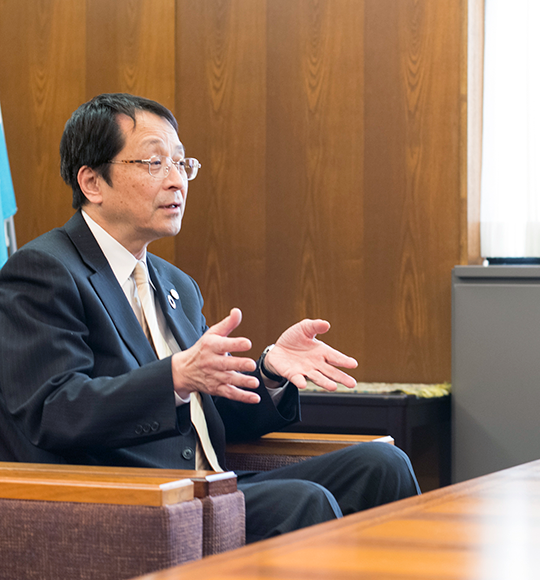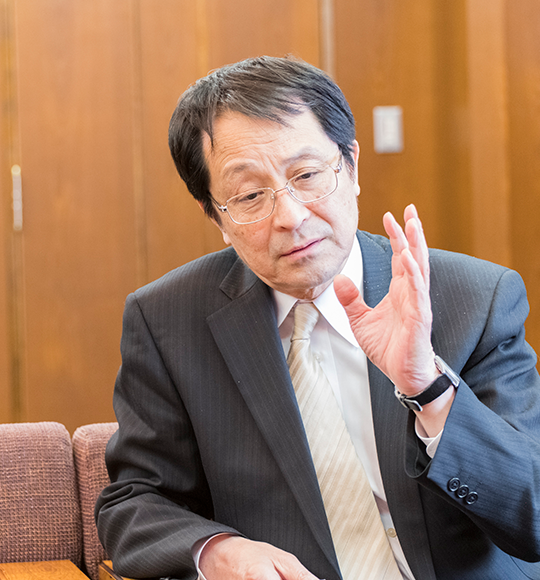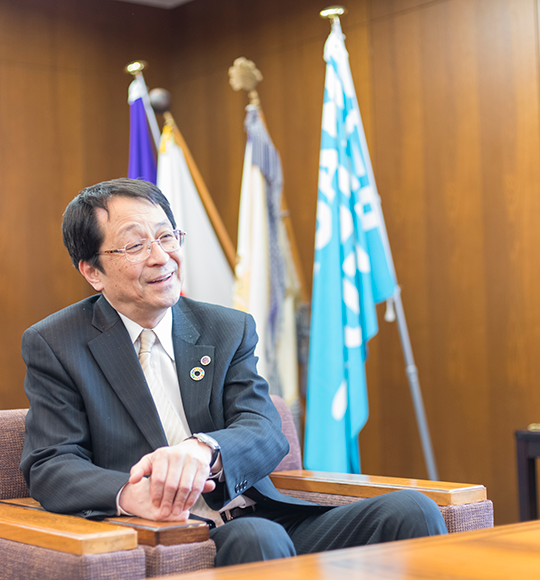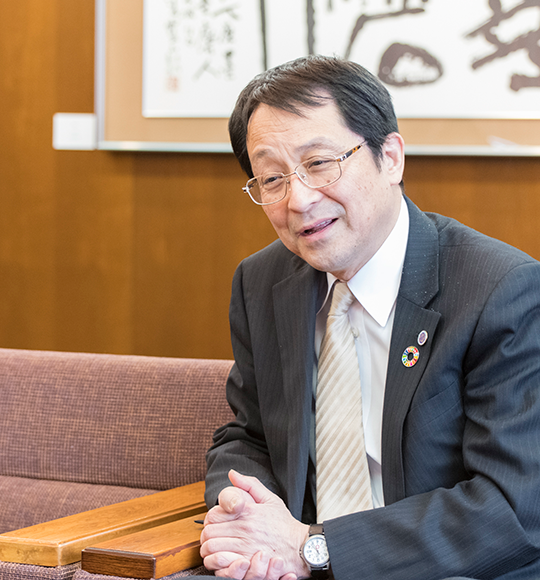MESSAGE
NAGATA Kyosuke
President of the University of Tsukuba
Setting our Focus on SDGs and Beyond as a University and People of Learning
The heart of a university is steadfast dedication to advancements in research and education that contribute to society. We must come up with solutions to questions not yet answered by looking beyond sustainable development goals.

The consciousness of a research university
Of the utmost importance is that we figure out to what extent we can contribute to SDGs, but not simply apply University of Tsukuba initiatives to the SDGs.
The University of Tsukuba is a research university. The creation of knowledge and the cultivation of human resources are both rooted in the act of research. We are taking initiatives daily to handle a myriad of issues that must be resolved based on a comprehensive framework of our fundamental, applied and developmental research, and pass the knowledge obtained in these efforts to the people we educate. It is vital that each of our researchers first and foremost be conscious of how they are satisfying SDGs in the course of their research.
One side of all our research is contribution to SDGs. One such example is in our battery and catalyst research. At first glance, it might seem like this research has nothing to do with SDGs, but that is not the case. Storage batteries are essential to energy conservation. Even if a large amount of electricity is produced, it can only be discharged unless we have the technology to store it. Research on batteries and catalysts for developing the technology for this storage is deeply connected to fulfilling SDGs.
For my next example, let’s imagine a world where humans and robots live in harmony. Robots show strong potential in a variety of fields, from nursing care support to transportation, so that robotics research satisfies the SDG slogan, “leaving no one behind”, and shows promise in making great contributions to their fulfillment. Furthermore, close connection between humans and robots will necessitate laws for support of that connection. For example, suppose an elderly person who has lost their family is spending the remainder of their days with a robot dog, but someone breaks that dog. Under current law this would be damage of property, but from the perspective of that elderly person, this act would be closer to loss of life. How we account for such sentiment within laws and regulations is one of the issues that must be resolved.

Researcher comprehension of societal contribution
If you are short-sighted in the way you look at your research, you may not see the way it is connected to SDGs, but if you take the long view, you may discover those connections in surprising places. It is not until we meet these requirements that we can achieve the sustainable development that will maintain the health of our planet and create a society that’s easier to live in where everyone can pursue happiness.
In pursuit of convenience and efficiency, implementation of results born of industry-university collaborative research in the form of products and social systems may go against the fulfillment of SDGs. We must ensure this does not occur. Constant awareness of the connection between each researcher’s research and society is what leads to true societal contribution.

Educational practices from the perspective of SDGs
It is our hope that current students who will shoulder the weight of society will become people who understand a multitude of social matters and take action upon themselves. Because SDGs are globally universal goals, they make for easy-to-understand teaching guidelines.
At our university, we recommend and practice Musha Shugyo-style (knight errantry) study. This style of education allows students to select issues, gather the required information, and present results all on their own.
One of these Musha Shugyo-style courses is the Kamado Project, which has been undertaken by our students in Art and Design department In this project, the students travel to areas that have been stricken with disaster, then build a Kamado stove to make food together with the area’s victims in order to contribute to its revitalization. Gathering around the fire to make food has become essential to revitalization efforts because it provides mental care and improves motivation. While a number of difficulties accompany the planning and implementation of projects like this, they help to foster the perspective and approach of SDGs in the students who participate.
Physical education is based on comprehensive sciences that include humanities, engineering, natural sciences, and athletics. We conduct academic research regarding the Olympics. Though the Olympics are held every four years as a sports competition, their ultimate goal is fostering world peace. The Paralympics were started from the Olympics in the spirit of “leaving no one behind” as advocated in SDGs. Therefore we consider the peace-seeking Olympics, themselves, to be a part of SDG fulfillment.

What lies beyond the fulfillment of SDGs?
It is predicted that SDGs will be fulfilled in 2030. At that time, it will be vital that we not become complacent and instead be able to work towards moving to the next step.
If we consider the present state the destination, then the progress of humanity and society comes to a halt. There is no point to being a university if we cannot discover what is beyond the SDGs based on our awareness of both the past and present.
In the future, the structure of society will change dramatically. It is predicted that at least 50% of jobs will be lost due to the proliferation of AI, so we must closely monitor the dynamics of society moving forward. It is dire that we pursue what it is that only people can do. We have to build new forms of scholarship in order to discover what is needed to face and overcome the unknown. Cross-contextual university activities are essential to our exploration of what lies beyond the SDGs once they have been fulfilled.
At present, I have no answer to the question of what lies beyond once the SDGs have been fulfilled. This is what we and the students of our university must now consider. But, instead of providing the answer, we will find it together through trial and error. That is the way of university research and education.




